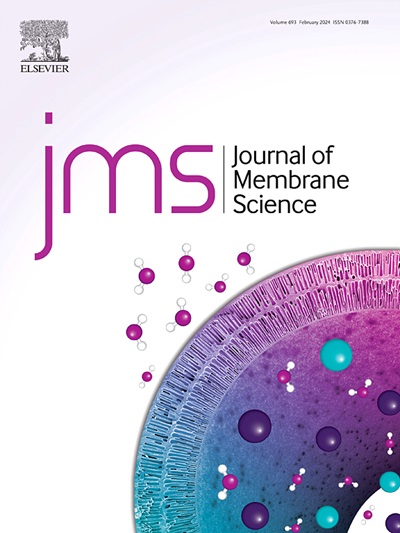A novel hierarchical catalytic ceramic membrane for removal of sulfamethoxazole by peroxymonosulfate in complex water matrices: the advantages of the membrane-based oxidative degradation system
IF 8.4
1区 工程技术
Q1 ENGINEERING, CHEMICAL
引用次数: 0
Abstract
Peroxymonosulfate (PMS)-based advanced oxidation process (PMS-AOP) is a promising technology for water decontamination. However, the application of PMS-AOP is limited due to the susceptibility of traditional batch reaction systems to impurity interference and low mass transfer efficiency, which makes the membrane-based catalytic system an excellent alternative. In this study, a hierarchical catalytic ceramic membrane coupled PMS-AOP system was constructed. In the membrane-based catalytic system, the directional flow carrying the reactants accelerated the contact between the PMS and the catalytic components, the spatial confinement effect shortened the mass-transfer distance between the reactants, and the tortuous structure ensured the sufficiency of the catalytic reaction. The system achieved a high degradation efficiency of 85 % for sulfamethoxazole (SMX) in a continuous degradation reactor with a flow rate of 79.4 Lm−2h−1, while demonstrating high customizability, broad spectrum and environmental tolerance. Furthermore, the selectivity of the system was improved by the addition of a separating layer to isolate interfering substances, resulting in SMX degradation efficiencies of >80 % in both humic acid solution and actual wastewater, while also achieving total organic carbon (TOC) removal rates of >70 %. Finally, the possible degradation pathways of SMX were proposed through theoretical calculations, revealing the hierarchical catalytic ceramic membrane coupled SR-AOP system holds significant promise for treating micropollutants in complex aqueous matrices, thereby reducing their environmental toxicity.

一种新型分级催化陶瓷膜在复杂水基质中通过过氧单硫酸盐去除磺胺甲恶唑:膜基氧化降解系统的优点
基于过氧单硫酸盐(PMS)的高级氧化工艺(PMS- aop)是一种很有前途的水净化技术。然而,由于传统的间歇反应体系易受杂质干扰和传质效率低,PMS-AOP的应用受到限制,这使得膜基催化体系成为一个很好的替代方案。在本研究中,构建了陶瓷膜耦合PMS-AOP体系。在膜基催化体系中,携带反应物的定向流动加速了PMS与催化组分的接触,空间约束效应缩短了反应物之间的传质距离,弯曲的结构保证了催化反应的充分性。该系统在连续降解反应器中对磺胺甲恶唑(SMX)的降解效率高达85%,流速为79.4 Lm−2h−1,同时具有高可定制性、广谱性和环境耐受性。此外,通过添加分离层来隔离干扰物质,提高了系统的选择性,在腐植酸溶液和实际废水中SMX的降解效率均达到80%,总有机碳(TOC)去除率达到70%。最后,通过理论计算提出了SMX可能的降解途径,揭示了分级催化陶瓷膜耦合SR-AOP系统在处理复杂水基质中的微污染物,从而降低其环境毒性方面具有重要的前景。
本文章由计算机程序翻译,如有差异,请以英文原文为准。
求助全文
约1分钟内获得全文
求助全文
来源期刊

Journal of Membrane Science
工程技术-高分子科学
CiteScore
17.10
自引率
17.90%
发文量
1031
审稿时长
2.5 months
期刊介绍:
The Journal of Membrane Science is a publication that focuses on membrane systems and is aimed at academic and industrial chemists, chemical engineers, materials scientists, and membranologists. It publishes original research and reviews on various aspects of membrane transport, membrane formation/structure, fouling, module/process design, and processes/applications. The journal primarily focuses on the structure, function, and performance of non-biological membranes but also includes papers that relate to biological membranes. The Journal of Membrane Science publishes Full Text Papers, State-of-the-Art Reviews, Letters to the Editor, and Perspectives.
 求助内容:
求助内容: 应助结果提醒方式:
应助结果提醒方式:


